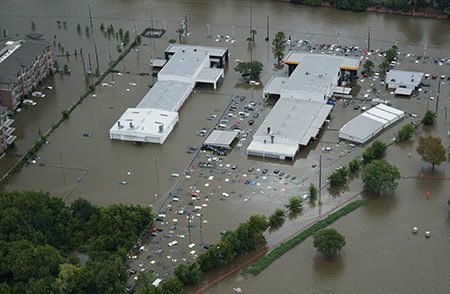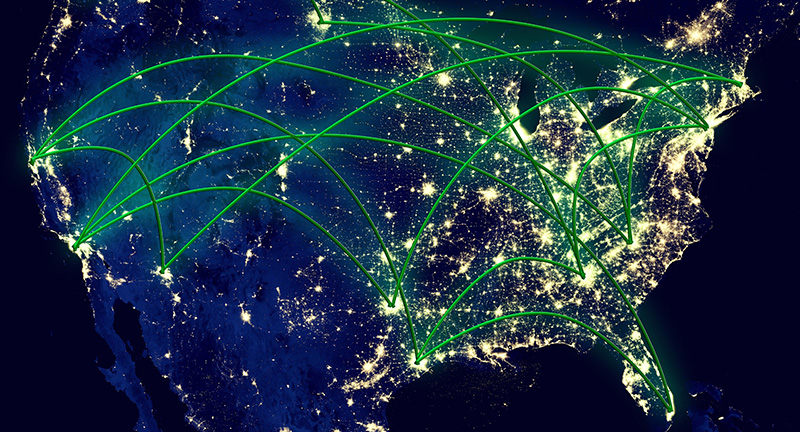As the scale of the destruction wrought by the earthquake and subsequent tsunami that devastated Japan’s north-eastern coastline in March 2011 became apparent, managers within BMW’s purchasing function were asked if it would affect the company. Their answer? No – because BMW had no suppliers in Japan.
But that wasn’t quite the case. A few days after the earthquake struck, recalls Alexander Scholz, head of project management in BMW’s sourcing and supplier network, the carmaker discovered that some critical tier four semiconductors came from north-eastern Japan. Probing more deeply, the company discovered several more instances of supply chains terminating in that region – in some cases, at factories that were the sole source of the components and materials in question.
Renesas Electronics, for example, the world’s largest manufacturer of automotive microcontrollers, was forced to cut production by 70%, shifting from its badly damaged Naka wafer fabrication factory in the Japanese coastal city of Hitachinaka to a number of other sites around the company. Altogether, output was suspended at seven of the company’s 22 plants.
Another case was a metallic paint pigment called Xirallic, which turned out to be produced at only one factory in the world, a plant located in the Japanese coastal town of Onahama, owned by German-owned manufacturer Merck Group. Used on the BMW 5 Series, the pigment was also relied upon by manufacturers as diverse as Chrysler, Toyota, General Motors, Ford and Volvo – all of which were forced to restrict production of vehicles in the affected colours. The plant was not able to re-open until eight weeks after the earthquake.
For BMW, explains Scholz, these events in Japan served as a wake-up call. Rather than continue to respond to supply chain disruption through crisis management techniques, it resolved to be more proactive in terms of supply chain risk management. More specifically, a decision was made to use emerging technologies to digitally overlay disruptive events on a global map of all its suppliers, irrespective of their tier. If something happened, BMW wanted to know about it and wanted to be able to react to it to protect production.

It’s a path since followed by others. Data feeds, many of them free, provide rich, real-time information on weather, seismic activity, traffic congestion, aircraft and shipping movements, and many other sources of risk and disruption. And freely available programming tools make available a means of interrogating social media accounts for a selection of keywords. Creating a digital map to show supplier locations isn’t rocket science; nor is displaying disruptive events on a map. But combining the two in real time provides instant insights that might otherwise take days to filter through a supply chain.
“For BMW, it was a strategic decision to put itself in the position of being able to respond first and fastest and, as a result, get an edge on the competition,” says Richard Wilding, professor of supply chain strategy at Cranfield University’s Cranfield School of Management.
Wilding points to the well-known story about how mobile phone manufacturer Nokia got the edge on rival Ericsson in the aftermath of a fire at a Philips microchip plant that supplied both companies. “If disaster struck, [BMW] wanted to have the option of being a Nokia, not an Ericsson – which paid the price for having taken the decision to single-source.”
How resilient is the automotive supply chain?Wilding stresses that early response does not in itself add much to supply chain resilience. As BMW discovered, a global map that highlights suppliers located in known danger spots prompts the need to think about sourcing decisions and safety stocks: fairly quickly, a decision was made to hold several weeks’ worth of Japanese-sourced semiconductors as a buffer. And after the events of 2011 and others that followed, the carmaker is not alone in holding more inventory of critical parts sourced from Japan.
“Ultimately, it is changes to supply chain and sourcing practices that will render supply chains more resilient,” says Wilding. “Better information is only part of the story: the trick is to use that information to do things differently.”
With the last couple of years once again demonstrating that earthquakes and extreme weather can happen almost anywhere – think the two earthquakes that hit the Japanese island of Kyushu in April 2016 as well as the hurricanes that battered the Caribbean and the US south-eastern seaboard in summer last year – are the automotive industry’s supply chains any more resilient than they were seven years ago, when 2011’s earthquake and tsunami struck?
It’s a deceptively complex question. To start with, ‘resilience’ is difficult to measure: how can you measure the effects of plant shutdowns and production disruption that never happen because contingency plans swing into place or because sourcing decisions are made differently?
But the question is important, because in the hard-nosed world of automotive procurement, financial justification is usually required to support any decision that might add to costs – like dual sourcing or near-shoring. It is, in short, one thing to think that a supply chain is more resilient and quite another to demonstrate and prove that resilience.
 "Ultimately, it is changes to supply chain and sourcing practices that will render supply chains more resilient. Better information is only part of the story: the trick is to use that information to do things differently." - Richard Wilding, Cranfield University
"Ultimately, it is changes to supply chain and sourcing practices that will render supply chains more resilient. Better information is only part of the story: the trick is to use that information to do things differently." - Richard Wilding, Cranfield University
Such disasters are diverse in nature and geographical spread, which makes planning for them difficult. Plans made after the 2011 Japanese earthquake and tsunami, for example, or after the disruption caused by the ash clouds from the 2010 eruption of a volcano in Iceland – which closed much of Europe’s air space and halted production at multiple plants in the region and beyond – were of little help in the face of the Thai floods of October 2011. These simultaneously hit seven of the country’s largest industrial zones, flooding Honda and Toyota plants as well as many suppliers. Once again, the knock-on effects were felt far away, with parts shortages at Honda’s Swindon plant in the UK causing production to drop to a three-day week.
On top of all that, the large-scale natural disasters that cause the most significant disruption are, thankfully, rare – providing infrequent opportunities for carmakers to properly assess their supply chain resilience.
Experts are somewhat divided on just how much more resilient supply chains have become. There has been progress, and changes have been made. True resilience, however, is still something of a work in progress.
“My suspicion is that not as much has been done as the hype would suggest,” says Richard Gane, a longstanding automotive industry expert and director of sourcing and supply chain consultancy, Vendigital. “But undeniably, dual-sourcing has become more acceptable: formerly, the push was towards single sourcing, and that has changed. And in terms of the drive to eliminate inventory from the supply chain, that, too, has changed – there’s a greater recognition that longer supply chains are probably riskier supply chains.”
No longer, for instance, is paint pigment Xirallic sole-sourced: these days, Merck keeps months’ worth of supply at warehouses both in Japan and other regions. A second production line was also opened up in Germany in 2012.
More proactive approachesCompared to even five or six years ago, manufacturers and logistics service providers have more visibility over where materials are, too, helping them to better visualise and plan their way around production difficulties, says Neal Williams, group managing director of emergency freight specialist, Priority Freight.
“They’ve become much better at understanding what is in their ‘warehouses in the sky’ or ‘warehouses on the ocean’ and are much more adept at switching production to reflect parts availability – which, in turn, has been helped by the prevalence of multi-model assembly lines. When things go wrong, they tend to over-produce those vehicles that they can actually produce,” he says.
[mpu_ad]Brad Brennan, managing director for premium freight specialist Evolution Time Critical, says recent natural disasters and unanticipated market spikes in North America have demonstrated that OEMs have become more agile in reacting to or anticipating disruption. He points to better contingency planning, including with specialist providers, but also through a deeper understanding of the supply chain, including down to the tier four level or beyond.
“Re-routing of shipments, resourcing, or moving heavy tooling and live production are all examples of proven contingency methods that have been utilised to sustain production following natural disasters in recent years,” he says. Evolution, which is owned by Canadian logistics group Metro Supply Chain, recently launched a critical project service to manage such operations specifically.
Some car companies are also becoming more adept at balancing the costs of dual-sourcing and additional inventory against the costs of emergency freight, adds Ron Glowinsky, vice-president for global sales at emergency freight provider CNW-Courier NetWork.
“There’s a greater openness to the possibility that disasters will occur and that a policy of budgeting and planning for them, and choosing the best partner for their own particular critical shipment needs, can provide a more effective response,” he suggests.
Priority Freight’s Williams also detects a greater willingness, at least among some companies, to consider emergency freight options more proactively, setting up framework agreements with emergency freight providers to save time when disaster does strike, with contingency plans already set up.
"[OEMs have] become much better at understanding what is in their ‘warehouses in the sky’ or ‘warehouses on the ocean’ and are much more adept at switching production to reflect parts availability." - Neal Williams, Priority Freight
“It saves valuable time: when difficulties arise, the framework is already in place for our people to join an auto manufacturer’s own supplier technical assistance team on the ground, and be ready to deal with the logistics dimensions of whatever the root cause of the problem is,” he notes. “Such agreements aren’t universal – particularly in continental Europe, where there can be a tendency to see road transport as a commodity – but where they are in place, the benefits can be considerable.”
Brad Brennan also points to a more proactive approach to preparing and reacting to disruption, which, in turn, has helped companies like his to “think more like a vehicle or tier supplier” when developing contingency plans.
“Manufacturers [increasingly] display a willingness to work closely with a dedicated multimodal emergency logistics provider in a proactive fashion – not just when things have gone wrong – thanks to an acute awareness of the benefits that can be brought by a flexible, highly responsive approach,” he says.
If you have the data, use itIncreasingly, too, companies are seeking to get smarter at taking sourcing and inventory decisions that might impact on supply chain resilience, says Hugh Williams, managing director at supply chain consultants Hughenden Consulting. The argument is that rather than reacting retrospectively and moving production from regions when flooding, earthquakes or tsunamis have already affected them, it is better to respond in advance, based on known risks rather than hard-won experience.
“Globally, there’s a wealth of resilience-relevant data being generated: the challenge is analysing it and getting value from it,” he points out. “And rather than perform that analysis themselves, it can be attractive to use specialist providers, where those providers exist.”
Increasingly, those providers do exist. DHL, for instance, offers just such a capability, as does sourcing and e-commerce platform SAP Ariba, information provider Thomson Reuters, and others.
 Service providers report a growing willingness in automotive supply chains to use emergency logistics options, including those based on air freight
Service providers report a growing willingness in automotive supply chains to use emergency logistics options, including those based on air freightBMW has started to go further than supply chain mapping. At its Spartanburg plant in South Carolina, for example, the carmaker has recently installed a new control-room type setup, using a combination of information and weather feeds together with software from SAP-based software provider Leogistics. The control centre combines real-time trucking information, inventory status at the plant and live production information, allowing the carmaker’s material controllers to make highly informed decisions based on real-time data.
SAP Ariba’s system, meanwhile, pulls in data from hundreds of thousands of sources and tracks over 130 different types of risk events, issuing alerts to customers as appropriate. Quite deliberately, explains Marcell Vollmer, chief digital officer at SAP Ariba, the solution embraces not just extreme weather and other types of natural disasters, but also a wide range of other relevant risks: financial, compliance-related, environmental and operational risks such as border closures, aviation incidents and maritime disasters, for instance.
“The reality is that it’s not always possible to predict and prepare for catastrophic events,” he notes. “But it is possible to plan and prepare for other risks, and so it is sensible to do that: it’s better to take a holistic view of risk, rather than a narrow one. Our customers, including one of the big three automakers, asked us about risk management and if big data could help – and our risk management solution is the result.”
For its part, DHL reports year-on-year growth of over 100% in the sales of its subscription- and cloud-based risk management solution DHL Resilience360, says Tobias Larsson, vice-president and head of DHL Resilience360.
“Initially, back in 2012 when we first developed it, it was seen as something of a ‘nice-to-have’ solution, but perceptions have now shifted. It’s not quite a ‘must-have’ but it’s getting to that point. Knowing the granularity of the warnings and alerts that it is possible to have these days, customers often look at developing the required capabilities themselves and then come to third parties like ourselves when they see the costs and complexities of doing this.”
As is becoming common with such solutions, DHL’s Resilience360 offering combines conventional data feeds containing information on weather, seismic activity, port congestion and other risks with analytics targeted on searching online and social media early warnings of disruptions, including supplier-specific disruption.
"The reality is that it’s not always possible to predict and prepare for catastrophic events. But it is possible to plan and prepare for other risks, and so it is sensible to do that: it’s better to take a holistic view of risk, rather than a narrow one." - Marcell Vollmer, SAP Ariba
[related_topics align="right" border="yes"]“For example, we’ll search for suppliers’ names using a very detailed taxonomy, looking for specific risks, such as a supplier’s name and ‘cyber-attack’,” he explains. “The idea is to give a customer relevant risk information six to eight hours ahead of when they might otherwise have had it, because that six to eight hours is often enough to put in place appropriate contingency and mitigation actions.”
That said, the onus is still on customers to be able to identify their tier two, tier three and tier four suppliers, and to know where all of their suppliers actually produce the products and materials destined for them. However, as BMW’s Scholz found out when the carmaker developed its own risk management system, this is no easy matter.
“In theory, it’s not difficult: all that is needed is the address. But in practice, when you check that address against Google Earth, there’s no factory there – what you have is the location at which invoices are processed,” he explains. “For supply chain disruption alerts to be meaningful, it’s important to know where production actually takes place.”
The bottom line may be that for measures to enhance supply chain resilience to be really effective, both carmakers and their tier suppliers still need to know a lot more about their respective supply bases than they probably do at present.
Topics
- Air Freight
- Analysis
- Asia
- BMW
- BMW
- Canada
- Chrysler
- cnw
- CNW
- Courier NetWork
- Cranfield School of Management
- Cranfield University School of Management
- DHL
- Emergency logistics
- Europe
- Evolution Time Critical
- features
- Ford
- Ford
- General Motors
- Germany
- GM
- Honda
- Hughenden Consulting
- Iceland
- Inbound Logistics
- Inventory management
- Japan
- Leogistics
- Merck Group
- Mexico
- North America
- OEMs
- Plant Logistics
- Priority Freight
- Renesas Electronics
- SAP Ariba
- Suppliers
- Supply Chain Planning
- Thailand
- Thomson Reuters
- Toyota
- United States Of America
- Volvo


























![Global[1]](https://d3n5uof8vony13.cloudfront.net/Pictures/web/a/d/s/global1_726550.svgz)













